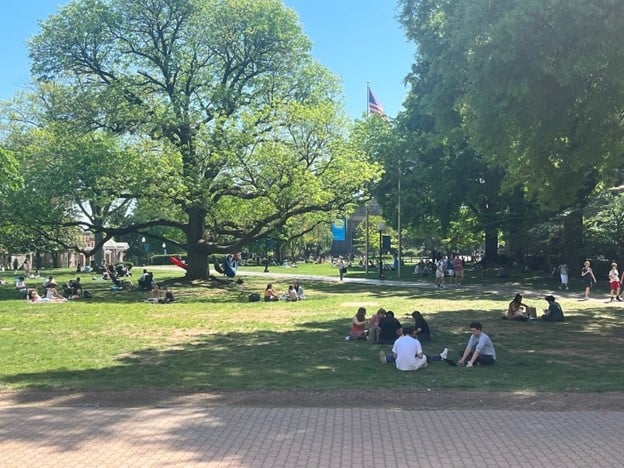You have /5 articles left.
Sign up for a free account or log in.

Too beautiful a day to be inside.
Vanessa Corcoran
It’s mid-April in D.C., which means for about 10 whole days we are in the sweet in-between of spring: our shortest and most glorious season. The cherry blossoms have bloomed, the tourists are flooding the National Mall and our Georgetown students have taken over the campus quad. They’re playing Frisbee, sitting in hammocks or sprawled on blankets. It is also that time in the semester when our students’ energy in class is flagging—they’re so ready to be done with the semester.
As a professor and advising dean, I’m empathetic to their plight. We’ve all put a lot of time into this semester, and the promise of summer is just on the horizon.
While waiting for a cold brew at the coffee shop, I was trying to mentally rally to lead my history seminar. If I was feeling depleted already, how enthusiastic were my students going to be for a 2.5-hour discussion? The caffeine was only going to make a limited difference. So what activities or probing questions were going to liven class up?
I walk into class with one idea in my back pocket—it’s something that can only be used sparingly. Everyone is seated, looking a bit tired.
“Now that we’re all here,” I begin, “let’s have class outside.”
They literally cheered. “Really?” And with that, we spent the next couple of hours breathing fresh air and still having a productive discussion. But they looked so much happier than they did just a few minutes prior. I felt better, too. There was a collective sense of relief, and it carried through not just our class, but the rest of the day.
Going outside reminds us of our childhood, right? All my toddler wants is to go outside. Even when her daycare has spent the afternoon outside, Lucy still wants to go to the playground after school. And that sentiment is felt among the college students, too—they’re trying to soak up the gorgeous weather and ability to play outside while they have the chance.
The students are watching what we as professors and administrators are doing. They’re picking up our cues in terms of not just how we function in the classroom, but all of our working tactics/modalities. They pick up on if we’re responding to emails at all hours. Not only do they then expect us to respond to emails at all hours, but they think they need to be plugged in 24-7 as well. Are we role modeling good behavior? If we’re tethered to work at all times, we’re not much different from their all-nighters: something we regularly discourage students from doing. Instead, can’t we show them firsthand that fresh air and a change of pace are things we all value?
Was my class 10 percent less productive than an indoor class? With the planes and noise of passersby, yes, it did sometimes pull focus. But was it 100 percent happier? Absolutely.







